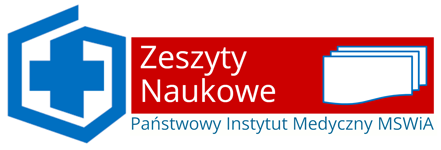How optimally treat patients with heart failure?
1
Wydział Medyczny. Collegium Medicum, Uniwersytet Kardynała Stefana Wyszyńskiego, Polska
2
Wydział Lekarski, Warszawski Uniwersytet Medyczny, Polska
3
Klinika Kardiologii, Państwowy Instytut Medyczny MSWiA, Polska
Submission date: 2023-02-15
Final revision date: 2023-05-08
Acceptance date: 2023-05-31
Publication date: 2023-05-31
Corresponding author
Zeszyty Naukowe PIM MSWiA 2023;1(1)
KEYWORDS
TOPICS
ABSTRACT
Introduction and objective: Modern HF therapy is based on the use of drugs from the group of ACE-inhibitors (ACEI/ARNI), beta-blockers, aldosterone antagonists (MRA), flozins and loop diuretics as a complement. Particular attention should be paid to the breakthrough in the treatment of patients with HFpEF and the inclusion of a new group of drugs, flozin, empagliflozin and dapagliflozin, which have an additional advantage, i.e. a protective effect on the kidneys. What's already known about this topic?: The latest definition of HF defines this disease entity as a clinical syndrome characterized by specific symptoms caused by abnormalities in the structure and function of the heart. According to the current guidelines of the ESC from 2021, HF can be divided according to the ejection fraction (EF) value into HF with reduced ejection fraction - EF values ≤ 40%; NS with mildly reduced ejection fraction - values 41%-49% and HF with preserved ejection fraction - value ≥ 50%. Patients with improved ejection fraction were also distinguished. Abstract: There have been many changes in the treatment of HF in recent years. It is necessary that the treatment is constantly improved, bearing in mind that heart failure is not a single diagnosis, but a multi-symptom syndrome that affects the whole body, daily functioning and life expectancy. The basic treatment in HF is pharmacotherapy, where 20 years ago diuretics and ACE inhibitors were the basis of treatment, and digitalis glycosides, vasodilators and b-blockers were used additionally. Currently, we use a regimen based on four groups of drugs: blockers of the renin-angiotensin-aldosterone system (ACE-I, ARNI), β-blockers, sodium-glucose co-transporter inhibitors (dapagliflozin, empagliflozin), and mineralocorticoid receptor inhibitors. Invasive methods of treatment have also become the standard in the treatment of this disease entity. These include: implantable cardioverter-defibrillator (ICD), ventricular resynchronization pacing (CRT) and left ventricular assist systems (LVAD), which significantly improve the prognosis in heart failure.
We process personal data collected when visiting the website. The function of obtaining information about users and their behavior is carried out by voluntarily entered information in forms and saving cookies in end devices. Data, including cookies, are used to provide services, improve the user experience and to analyze the traffic in accordance with the Privacy policy. Data are also collected and processed by Google Analytics tool (more).
You can change cookies settings in your browser. Restricted use of cookies in the browser configuration may affect some functionalities of the website.
You can change cookies settings in your browser. Restricted use of cookies in the browser configuration may affect some functionalities of the website.


